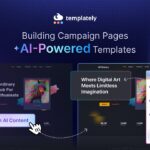The world of website design is evolving at an unprecedented rate. If you are wondering what is coming next and how to keep your website relevant, you are not alone. The digital world is evolving rapidly, and staying ahead means understanding not only current trends but also preparing for what is to come next.

In this comprehensive guide, we will explore the future of website design, starting with AI-generated content and expanding into other crucial trends you should adopt to stay competitive.
AI in Web Design: Innovations Reshaping Digital Experiences
From automating content creation to enhancing user experiences and optimizing design decisions, AI is playing a critical role in shaping the future of how websites are built, function, and evolve.
Let’s explore the key AI-driven trends that are already influencing modern website design and what you should be paying attention to as you plan for the future.
AI-Generated Content at Scale
AI tools like ChatGPT, Jasper, and Copy.ai are changing how we create content for the web. Businesses can now quickly generate engaging copy, product descriptions, FAQs, and blog articles. This saves time and reduces costs.
AI ensures content consistency and can be customized to match brand tone and user intent, making it an ideal solution for both large enterprises and resource-strapped startups.
Personalized User Experiences
AI is making it easier than ever to deliver content that feels custom-made. By analyzing user behavior, preferences, and demographics in real-time, AI can personalize web experiences.
For example, showing different headlines, offers, or even entire layouts to different users. This not only boosts engagement but also improves conversion rates by delivering what users are most likely to respond to.
Intelligent Layout and Design Optimization
Gone are the days of relying solely on manual A/B testing. AI-powered design tools can automatically experiment with different UI elements, color schemes, content placements, and call-to-action buttons. These systems continuously learn and optimize to identify which design variants perform best, helping websites achieve better results with less guesswork.
AI-Driven Visual Design
AI can now assist with generating unique images, graphics, and even entire page mockups. Tools like Midjourney, Adobe Firefly, and Canva’s Magic Design empower designers to experiment more freely or provide non-designers with fast, professional-looking visuals. Some platforms also use generative design to auto-create layouts based on content hierarchy and user behavior predictions.
Conversational & Voice-Enabled Interfaces
As voice search and smart assistants gain popularity, web design is shifting accordingly that accommodate voice-driven interactions. AI helps structure content and optimize technical aspects (like schema markup) for better voice search visibility. Meanwhile, AI chatbots offer real-time assistance, guiding users through websites and improving customer support without human intervention.
Predictive Design Assistance
AI-powered design assistants are now capable of analyzing your existing website. Based on that, it can recommend improvements. From layout suggestions to UX enhancements, you can improve every aspect of your website design with the help of AI. Some AI tools can predict how users will interact with specific sections and propose structural changes to improve engagement or accessibility.
According to recent data, 79% of businesses are using generative AI in business functions as of 2024, up from 65% earlier that year. This shows how quickly AI adoption is growing across industries.
Web Design Trends: What Else You Should Adopt in 2025
The advantages of incorporating AI in web design are significant. But what are the future website design trends that you should consider? Here are other crucial trends shaping the future of website design,
1. Mobile-First Design is No Longer Optional

Mobile devices now dominate web traffic, and this trend is only accelerating. Mobile devices generate 60% of website traffic, making mobile-first design essential for success. Why does mobile-first matter?
- User behavior – Nearly 65% of global internet users access websites via mobile devices.
- Search rankings – Google prioritizes mobile-friendly websites in search results.
- User experience – Users with a positive browsing experience are more likely to return.
2. Clean, Minimalist Design Continues to Dominate
Users prefer simplicity over complexity. 84.6% of people prefer a clean outlook rather than a crowded page design. This trend toward minimalism is not just aesthetic; it is functional. Faster loading times, better user focus, improved accessibility, and enhanced mobile experience are some of the major benefits of minimalist design.
3. Interactive and Immersive Experiences
The future of web design is moving toward more interactive and engaging experiences. This includes elements like micro-animations, hover effects, and interactive storytelling that keep users engaged. Here are the key interactive elements to consider,
- Micro-animations – Small animations that provide feedback and guide user actions.
- Scroll-triggered effects – Elements that animate as users scroll through the page
- Interactive content – Quizzes, polls, and interactive infographics that engage users
- 3D elements – Three-dimensional graphics and animations that create depth and interest
4. Voice Search Optimization
With the rise of smart speakers and voice assistants, optimizing for voice search is becoming increasingly important. Websites need to be prepared for how people naturally speak rather than type. Considerable voice search optimization strategies are,
- Use conversational language in your content
- Focus on question-based keywords
- Optimize for local search queries
- Ensure fast loading times for voice search results
5. Sustainable Web Design
Environmental consciousness is influencing web design choices. Sustainable web design focuses on reducing the environmental impact of websites through efficient coding, optimized images, and green hosting solutions. Sustainable design practices that you should consider are,
- Optimize images and media files for faster loading
- Use efficient coding practices
- Choose eco-friendly hosting providers
- Implement dark mode options to reduce energy consumption
The Growing Importance of User Experience (UX) in Future-Forward Web Design

As the future of website design moves toward automation, personalization, and AI-generated content, one element remains timeless: user experience (UX). No matter how advanced your tools become, if your website does not offer a seamless and satisfying experience, users will not stay.
Modern users are more discerning than ever. They expect fast, intuitive, and accessible digital experiences across every device. To stay competitive, future-focused web design must adopt and evolve key UX principles:
- Speed is essential: Website load time is one of the biggest deal-breakers. A delay of even a few seconds can lead to high bounce rates.
- Accessibility is non-negotiable: Inclusive design ensures your content is usable by everyone, including those with disabilities, something that is becoming both a legal and moral imperative.
- Navigation must feel natural: Clear site architecture and intuitive navigation keep users engaged and help them achieve their goals faster.
- Device adaptability is critical: With users accessing websites from phones, tablets, laptops, and more, responsive design is a must, not an option.
As you adopt new technologies like AI-generated content, remember: innovation should enhance UX, not complicate it. The future of web design belongs to those who can balance cutting-edge features with human-centered experiences.
The Expanding Web Design Market: Preparing for The Future
The web design industry is evolving rapidly. It reflects the growing importance of a strong digital presence. Businesses are prioritizing professional, future-ready website design more than ever before.
As we move into an era dominated by AI-generated content and smart automation, the future of web design goes far beyond just adopting new tools. It is about building meaningful digital experiences powered by both innovation and intentional design.
Here are the key themes shaping the future that every designer, developer, and business should be ready to adopt:
- Blend AI with Human-Centered Design: From content creation to personalized user flows, AI in web design opens up powerful possibilities. But success lies in balance. Technology should enhance creativity and empathy, not overshadow them.
- Prioritize Speed & Performance: In a fast-paced digital world, users won’t wait. Future websites must be optimized for lightning-fast loading times, smooth interactions, and performance across all devices and networks.
- Design for Accessibility & Inclusion: Inclusive design is no longer optional. Future-forward websites must be accessible to users of all abilities, meeting both ethical standards and growing legal requirements.
- Stay Agile with User Behavior Trends: As digital habits shift, from voice search to mobile-first browsing, websites must adapt quickly. Understanding and responding to user behavior is key to long-term success.
Practical Steps to Future-Proof Your Website
As web design continues to evolve with AI, automation, and shifting user expectations, future-proofing your website is a necessity. The good news? You do not need a complete overhaul to stay ahead. By adopting forward-thinking practices now, you can build a strong foundation for long-term success. Here are actionable steps to align your website with the future of web design:
- Design Mobile-First: With mobile traffic dominating the web, start your design process with mobile in mind, then scale up for larger screens. This ensures a responsive, user-friendly experience across all devices.
- Integrate AI Thoughtfully: Start small—use AI for content generation, chatbots, or user personalization. As you get comfortable, explore more advanced AI-powered solutions that enhance UX without overwhelming your workflow.
- Optimize for Core Web Vitals: Focus on Google’s key performance metrics: loading speed, interactivity, and visual stability. These directly impact your SEO and play a critical role in user satisfaction.
- Ensure Meaningful AI-Generated Content: Whether generated by AI or crafted by humans, content should always be relevant, engaging, and purposeful. Invest in storytelling that builds trust and drives value, even if you write with AI.
- Test, Analyze & Iterate: Use analytics, heatmaps, A/B testing, and user feedback to identify what works and what doesn’t. Future-ready websites are those that evolve continuously based on real data.
- Stay Ahead of Trends: The web design landscape shifts fast. Subscribe to industry blogs, attend webinars, and follow design leaders to stay informed about the latest tools, frameworks, and trends shaping the future.
AI-Driven Website Design: Building Smarter, More Personalized Experiences
The future of website design is exciting and full of possibilities. AI-generated content is just the beginning of a transformation that will make websites more personalized, efficient, and engaging than ever before.
By embracing AI while also focusing on mobile-first design, clean aesthetics, interactive experiences, and excellent user experience, you can create websites that not only meet today’s standards but are also prepared for tomorrow’s challenges.
The key is to start now. Begin implementing these trends gradually, test what works for your audience, and stay flexible as the digital landscape continues to evolve. The future of web design is bright, and those who prepare today will be the ones who thrive tomorrow.
Remember, great web design is not just about following trends; it is about creating meaningful connections between your brand and your users through thoughtful, well-executed digital experiences.
Was this blog helpful to you? To get more blogs like this, subscribe to our blogs and join the Templately Community to connect with fellow enthusiasts.









